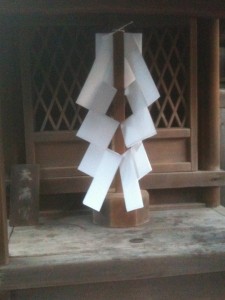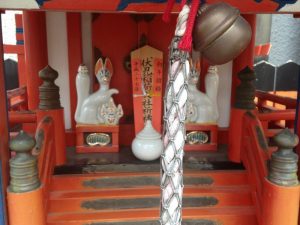Kami explanation by Olivia Bernkastel (Konkokyo Shinto priestess)

Olivia and friends on a visit to Kyoto last year
To worship kami, there is always a “goshintai”; or a sacred vessel for the kami’s spirit/energy which is considered as a “body” for the kami to alight to as a vessel permanently. This allows their energy to be present strongly with worshippers and clergy at a shrine.
There is also an item called “yorishiro”, which is a sacred item that calls to, or draws a kami’s energy. When the kami enters the yorishiro during prayer, it becomes a temporary goshintai, or vessel for the kami to dwell. After prayers finish, the kami leaves the yorishiro until the next prayers.
All shrines have goshintai, but at home altars, or kamidana, generally only have yorishiro, commonly in the form of ofuda. There are a few exceptions to this, one example being Fushimi Inari Taisha which does a special ceremony for sincere members, and thus ordinary people can receive a goshintai of Inari Okami to caretake at home.
Nowadays yorishiro usually takes the form of an ofuda, but as well natural items like a rock, tree, or gem can also be yorishiro. Gohei are used as goshintai, but they were also the original kind of yorishiro, before ofuda. It was standard for most kami. Mirrors were also quite common yorishiro, especially for Amatsukami. You can pray to kami anytime anywhere, but to have their energy presence alight near us, goshintai or yorishiro are needed to be present as the kami’s vessel.

Gohei stand
There are two kinds of kami traditionally. Amatsukami (Heavenly kami) and Kunitsukami (Earthly kami), with some kami in-between, or having aspects of both.
For Amatsukami, or kami in-between Amatsu and Kunitsu, the goshintai is a physical item. This is because Amatsukami and kami in-between usually are not tied to any particular Earthly feature.
Amatsukami and in-between kami need a physical item as a goshintai or yorishiro. Commonly a gohei, mirror, sword, or gem. It is because their true “body” is celestial and not Earthly or an Earthly location – like the sun, moon, sky, clouds, universe, etc. Or, something not tangible like Amatsukami of concepts, or non physical things. For example the kami of wisdom, Omoikane no Mikoto.
For Kunitsukami, the goshintai is usually an Earthly feature, such as a mountain, tree, rock, lake, ocean, or particular location, such as Mt. Fuji for Konohanasakuya Hime no Mikoto or Mt. Miwa for the kami of Omiwa Jinja.
A good example is Lake Suwa region for Suwa Daimyojin, with local folklore saying Suwa Daimyojin cannot leave the lake. So what should one do to worship him outside of Lake Suwa region? A new goshintai or yorishiro can be ritually made for him. There are Suwa branch shrines throughout the country. But how?
There are two main methods. One is at the main shrine (in this example, Suwa Taisha); a new goshintai is ritually made for the kami to be brought elsewhere at a new Suwa Shrine branch location. The other way is the new goshintai is ritually created at the new Suwa Shrine branch itself.

A small Inari shrine with an ofuda between the two white foxes.
What this means is that Suwa Daimyojin can be worshipped anywhere with the ritual creation of the new goshintai. This is called “bunrei” and the ritual ceremony is “kanjo”.
To describe bunrei with a metaphor: Let’s say the main shrine, Suwa Taisha in the Lake Suwa region, is the original “bonfire” of energy for Suwa Daimyojin.
Bunrei, and the ritual ceremony Kanjo is like lighting a “torch” (part of energy/spirit) from Suwa Daimyojin. When that torch is used to make a new “bonfire” at another shrine, the flame is from the original “bonfire” or energy/spirit of Suwa Daimyojin. Thus, they can be directly present both at Suwa Taisha and in the branch shrine. Of course it may be slightly stronger spiritually at Suwa Taisha due to the location’s own power and history.
While bunrei for goshintai is like lighting a torch from the original bonfire to create a new bonfire in another location with the original flame – creating ofuda, or a yorishiro, is like creating a “candle” which when you “light with fire” (pray) the kami can enter that “flame” (energy) temporarily during the prayer.
This is generally how kami have spread from their home area or original place of worship to shrines all across the country. A shrine overseas is no different and the same process can be done.
There are of course local spirits and ancient deities in each country, but I feel they should be respected in their own traditions rather than having Shinto rituals for them.
I personally think it’s not too respectful. When I lived in Canada, I simply left biodegradable offerings in the woods and said thank you to the local deities rather than doing a Shinto ceremony. I kept a kamidana in my home with an ofuda for the kamis who needed them and worshipped no different than in Japan.
***********
- Kokugakuin article explaining about Amatsukami and Kunitsukami: http://eos.kokugakuin.ac.jp/modules/xwords/entry.php?entryID=2
- While there is no technical word for kami having ties to both Amatsukami and Kunitsukami, here is the Kokugakuin article about Kamimusuhi no Mikoto, a well-known in-between kami: http://eos.kokugakuin.ac.jp/modules/xwords/entry.php?entryID=86
- Kokugakuin article about Bunrei and Kanjo ritual: http://eos.kokugakuin.ac.jp/modules/xwords/entry.php?entryID=1476
- Kokugakuin article about Shintai:
http://eos.kokugakuin.ac.jp/modules/xwords/entry.php?entryID=292 - Kokugakuin article about yorishiro:
http://eos.kokugakuin.ac.jp/modules/xwords/entry.php?entryID=296

Suwa Taisha, dedicated to a prime example of an ‘earthly kami’

Torc
Cynntheaw.wordpress.com
Sinister.runes@gmail.com
Very good read and I think a good primer for those looking to follow Shinto.
I find it interesting that she addressed local sprits outside of Japan and that she made offerings to them but not in Shinto style.
As I read through this article again, most of it makes sense but other points brought a question to mind.
“A good example is Lake Suwa region for Suwa Daimyojin, with local folklore saying Suwa Daimyojin cannot leave the lake. So what should one do to worship him outside of Lake Suwa region? A new goshintai or yorishiro can be ritually made for him. There are Suwa branch shrines throughout the country. But how?”
In the above example the kami, Suwa Daimyojin, cannot leave Lake Suwa, yet there are shrines dedicated to him and the reason given is that a goshintai was made and taken to the new location. If the kami cannot leave the lake, how could he or any part of him travel to a shrine and make use of the goshintai? I would think that offerings could only be placed in or at the edge of the lake for the very reason that he cannot receive offerings made to him in places he cannot travel.
Thank you, I will ask Ms Bernkastel for her response…
Hello Torc! It is Olivia here!
Basically according to folklore, as long as Suwa Daimyojin’s original spirit is not gone or leaves from Lake Suwa region, then any other locations he can be in is okay.
It sounds a little strange – but basically it’s the meaning of as long as his original spirit is still at/concentrated/present at Lake Suwa, the folklore and legend of him being unable to leave or rather very tied to that region is still intact.
Even if his spirit is present at another shrine – his spirit is still present at Lake Suwa region/Suwa Taisha. So he never truly “left”. If that makes sense. He never left, but still is present at other shrines due to the bunrei and kanjo ceremony as explained in the article.
Offerings are given to him in the haiden (worship hall) and honden (main enshrinement hall) for him at his spirit. It’s not so much the lake itself he cannot leave, but the whole surrounding Lake Suwa area. (Because it’s said that area and the Lake is his original vessel or body) And his spirit/kami is worshiped properly/given offerings at the shrine on the grounds, Suwa Taisha.
So he is not traveling or going away from the region during bunrei/kanjo ceremony. His energy (the original bonfire) remains intact. A part of his energy is split from him (a torch is lit from the bonfire, but the bonfire itself does not loose any of it’s flame), then that torch is used to make a new bonfire (his directly present energy) with the torch of the original flame, so it is still him.
A little hard to explain since kami are not bound by the same physics as people, so this is a very spiritual meaning.
If I were to maybe use a kind of better but not so physically accurate example, it would be kind of like if you could be present in two places at once physically. And as long as you are in your main home, you still haven’t technically left home even though you are also somewhere else.
I know it’s a bit confusing but I hope this could help make some sense!
Thank you, Olivia, for the clarification. This is an area I have been having some difficulty wrapping my mind around. I have been reading A year in the Life of a Shinto Temple by John Nelson and it has been shedding some light on the more intimate thoughts in regards to the Kami that aren’t always reflected in other works I have read.